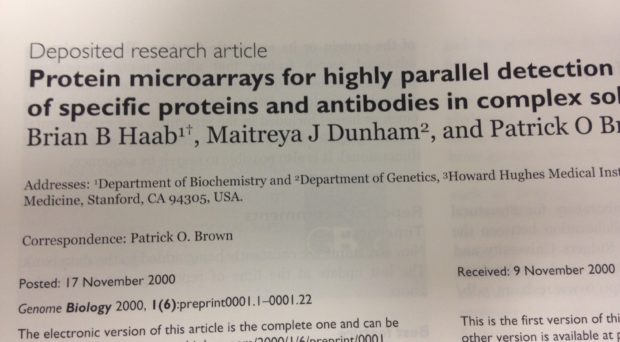
Back in 2000, Genome Biology started to publish what were called ‘Deposited research articles’. These were papers that had been submitted to the journal but were still in the process of being peer reviewed, and this was a new concept for biologists: using the internet to give scientists access to research results before publication in a journal. The idea didn’t take off back then and the article type was discontinued after a few years, but Genome Biology was essentially publishing biology preprints, way ahead of its time.
Many more traditional journals have taken their time to warm up to the idea of preprints, but right from the start Genome Biology felt that preprints were closely aligned to the journal’s attitude to openness and sharing. So Genome Biology has always been happy to consider papers that have been posted as preprints.
From today, researchers who post to bioRxiv will be able to submit their papers directly to Genome Biology, avoiding two separate submission processes and making the lives of authors that little bit easier. This will be a trial initially, but we are optimistic that our community – which includes many bioinformaticians, who were early adopters of preprints – will embrace the change. The experience of Genome Biology authors is also changing in other ways as a result of the continuing rise of preprints.
For some time now we have been scanning new posts on bioRxiv to look for papers that we might want to invite into the journal, guaranteeing peer review. We’ve pulled in some exciting studies in this way, and we feel that it benefits researchers, too, as it saves them time in submitting to several journals before getting an offer of peer review.
Something we do with more caution is use metrics and comments from preprints to help us decide whether we are interested in manuscripts that are formally submitted to us. If we are unsure about interest levels, seeing that a paper has been highly accessed on bioRxiv can support a decision to peer review.
We also look at comments that might raise concerns about a paper. The editors tread carefully here, looking closely at who has posted the comment for expertise and potential conflicts. Even if we see a potentially serious concern expressed as a comment, that doesn’t mean that we will necessarily rule out considering a paper – if we think that the paper has merit, we can make sure that issues are addressed during peer review. In this way, it is our belief that preprints can enhance the peer review process.
Recently, the 4D Nucleome consortium, funded by the US NIH, announced that all papers resulting from this program must be posted to a preprint server ahead of peer review. With moves like this, we predict that it will soon become the norm for biologists to post to a preprint server before submitting to a journal, and we embrace this change for all the benefits that it can bring.
Louisa Flintoft
Latest posts by Louisa Flintoft (see all)
- Ahead of the curve: embracing preprints - 14th December 2016
- The Human Cell Atlas: an audacious step towards self-knowledge - 18th October 2016
- Ask a geneticist: a Q+A with Louisa Flintoft - 22nd April 2016
Comments